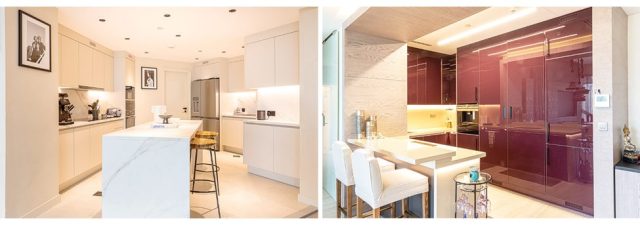In more ways than one, the kitchen is the heart of every home. It is the space that experiences some of the highest levels of activity in a home, with multiple functions incorporated in its layout. Additionally, on a more sentimental note, a kitchen serves as a backdrop to every family’s daily life. It allows room for people to gather and share meals together, ultimately bringing them closer together and cementing their relationships built around the act of preparing and consuming their favorite dishes.
With such a central place in the functionality of the home, it is important to pay heed to the spatial planning and layout of a kitchen interior. A well-designed kitchen operates with seamless precision while leaving room for individual inhabitants to modify it to their preferences without any kind of compromise on efficiency. To ensure the best possible design solution for your kitchen, we offer luxury kitchens in Abu Dhabi to cater to your specific needs. Here are some of the important aspects to be considered for a good kitchen layout:
1. Efficient Workflow
The dominant purpose of every kitchen is tied to its functionality as a space for preparing meals. To facilitate this purpose, the kitchen layout should be arranged so that the resulting workflow is as efficient as possible.
In order to achieve maximum efficiency, various aspects of the kitchen design should be taken into consideration, such as the counter space, position of appliances, and the various functional zones. The different zones of a kitchen act as the fundamental building blocks dictating the overall design. These include the food prep and cooking area, along with space dedicated to either consumable items, or non-consumable items.
Schedule a consultation with one of our designers to map out strategies to improve workflow efficiency in kitchens in Dubai.
2. Maximum Storage Space
To facilitate the kitchen workflow, it is imperative that storage be handled so that it aligns with the workflow layout. The items stored in a kitchen can be designated as either consumables, or non-consumables. By situating these around the kitchen to facilitate the workflow dictated by the layout, overall experience can be enhanced and streamlined. With a vast range of storage options available in the market, organizers can be incorporated into the cabinet design to ensure that every inch of storage space is properly utilized.
3. Multifunctional Spaces
A residential kitchen usually has to operate in a spatial constraint, which necessitates that the layout be planned so that a single space can accommodate multiple functions. Practically speaking, what would this look like? For instance, a countertop that is used for food prep can also double as a breakfast bar or a dining area.
By assigning more than one function to an area, you can multiply the possibilities of usage for each space. As a result, your kitchen will expand manifold in terms of functionality.
To explore possibilities of multifunctional spaces, browse our catalog of projects for kitchens in Oman.
4. Increased Safety
The nature of activity taking place in a kitchen leaves it susceptible to accidents and mishaps, especially fire related incidents. Good design can only do so much to mitigate the possibility, and one must always account for human error. Therefore, it is best to preemptively plan for a safety plan in such a scenario.
A well-designed kitchen will incorporate aspects of safety, such as fire hydrants, smoke detectors, and fire retardant materials. The resulting layout of the kitchen will then be designed to make access to these features a priority to ensure a safe working environment. At our practice, we strive to create as safe and secure a space as possible, without compromising on visual aesthetics.
5. Personalization
In the process of designing a kitchen layout, a designer can only go so far. A space can only truly come to life once it is being used by its inhabitants. Spaces tend to change over the span of time. As the needs of the residents evolve over time, spaces need to keep up with these changing patterns of use.
The process of personalization is one that allows the users to completely own the space and incorporate individual touches that reflect their choices, resulting in a unique design.
A well-designed kitchen is one that leaves room for personalization and modification according to the needs of individual residents. While the design of a residential kitchen should anticipate the user’s requirements, it is better to acknowledge that requirements may change over time and any space needs to evolve accordingly.
Get in touch with our designers to explore possibilities for personalizing kitchen design in Dubai, UAE.
6. Lighting and Ventilation
While aesthetic considerations should not be neglected, a kitchen space is one that should prioritize functionality above all else. To this end, the incorporation of lighting and ventilation plays a crucial role in the design of a kitchen.
In order for culinary pursuits to be carried out with ease, a space must be well-lit and well-ventilated. This can be accomplished by including lighting fixtures and windows/exhausts from the beginning of the design phase.
A successful space is always mindful of the user’s comfort. One must aim to strike a balance: a space that is neither dim nor overly bright, neither drafty nor stuffy.







